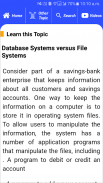










Database Management Systems

Description of Database Management Systems
The app is a complete free handbook of Database Management Systems (DBMS) which covers important topics, notes, materials, news & blogs on the course, also save/buy chapters for offline reading. Download the App as a reference material & digital book for Computer science engineering programs & Software degree courses.
This useful App lists 150 topics with detailed notes, diagrams, equations, formulas & course material, the topics are listed in 9 chapters. Works in offline mode. The app is must have for all the engineering science students & professionals.
The app provides quick revision and reference to the important topics like a detailed flash card notes, it makes it easy & useful for the student or a professional to cover the course syllabus quickly before an exams or interview for jobs.
Track your learning, set reminders, edit the study material, add favorite topics, share the topics on social media.
You can also blog about engineering technology, innovation, engineering startups, college research work, institute updates, Informative links on course materials & education programs from your smartphone or tablet or at http://www.engineeringapps.net/.
Use this useful engineering app as your tutorial, digital book, a reference guide for syllabus, course material, project work, sharing your views on the blog.
Some of the topics Covered in the app are:
1. Overview of Database Management Systems
2. Database Systems versus File Systems
3. History of Database Systems
4. View of Data
5. Extending Database Capabilities
6. Types of Databases and Database Applications
7. Advantages of Database Systems
8. Functions of a DBMS
9. Role of the Database Administrator
10. Database Users
11. Data Models
12. Components of Database Management system
13. Transaction
14. Database Management System Languages
15. The two tier architecture
16. Three-layer architecture
17. Entity-Relationship Model
18. Database design and ER Diagrams
19. Entity Types, Attributes and Keys
20. Relationships and Relationship sets
21. Types of Entity
22. Constraints
23. Keys
24. Entity-Relationship Diagram
25. Hierarchical Data Model
26. Network Data Model
27. Design Issues
28. Extended E-R Features
29. Alternative E-R Notations
30. The Unified Modeling Language
31. Relational Model Terminology
32. Mathematical Definition of Relation
33. Database Relations
34. Structure of Relational Databases
35. Database Schema
36. Keys
37. Schema Diagram
38. The Relational Algebra
39. Composition of Relational Operations
40. The Union Operation
41. The Set Difference Operation
42. The Rename Operation
43. Formal Definition of the Relational Algebra
44. Additional Operations
45. Extended Relational-Algebra Operations
46. Outer Join
47. Null Values
48. Modification of the Database
49. Views
50. Physical Storage Media
51. RAID
52. Tertiary Storage
53. Storage Access
54. File Organization
55. Variable-Length Records
56. Organization of Records in Files
57. Indexing structures for files
58. Secondary Indexes
59. Clustering File Organization
60. Data-Dictionary Storage
61. Hashing
62. B Tree
63. Query-by-Example
64. Queries on One Relation
65. Queries on Several Relations
66. The Condition Box
67. The Result Relation
68. Ordering of the Display of Tuples
69. Aggregate Operations
70. Normalization
71. Functional Dependency
72. The Process of Normalization
73. First Normal Form (1NF)
74. Boyce.Codd Normal Form (BCNF)
75. Fourth Normal Form (4NF)
76. Fifth Normal Form (5NF)
77. Algorithm for Functional Dependencies
78. Objectives of SQL
Each topic is complete with diagrams, equations and other forms of graphical representations for better learning and quick understanding.
Database Management Systems is part of Computer science, software engineering education courses and information technology degree programs of various universities.</br></br></br></br></br></br></br></br></br></br></br></br></br></br></br></br></br></br></br></br></br></br></br></br></br></br></br></br></br></br></br></br></br></br></br></br></br></br></br></br></br></br></br></br></br></br></br></br></br></br></br></br></br></br></br></br></br></br></br></br></br></br></br></br></br></br></br></br></br></br></br></br></br></br></br></br></br></br></br></br></br></br></br></br></br></br></br></br></br></br></br></br></br></br></br>



























